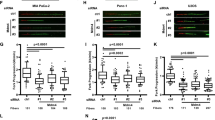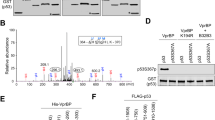Abstract
Under basal growth conditions, p53 function is tightly controlled by the members of MDM family, MDM2 and MDM4. The Mdm2 gene codes, in addition to the full-length p90MDM2, for a short protein, p76MDM2 that lacks the p53-binding domain. Despite this property and at variance with p90MDM2, this protein acts positively toward p53, although the molecular mechanism remains elusive. Here, we report that p76MDM2 antagonizes MDM4 inhibitory function. We show that p76MDM2 possesses intrinsic ubiquitinating and degrading activity, and through these activities controls MDM4 levels. Furthermore, the presence of p76MDM2 decreases the association of MDM4 with p53 and p90MDM2, and antagonizes p53 degradation by the heterodimer MDM4/p90MDM2. The p76MDM2-mediated regulation of MDM4 occurs in the cytoplasm, under basal growth conditions. Conversely, upon DNA damage, phosphorylation of MDM4Ser403 dissociates p76MDM2 and prevents MDM4 degradation. The overall negative control of MDM4 by p76MDM2 reflects on p53 function as p76MDM2 impairs MDM4-mediated inhibition of p53 activity. In agreement with the positive role of p76MDM2 toward p53, the p76MDM2/p90MDM2 ratio significantly decreases in a group of thyroid tumor samples compared with normal counterparts. Overall, these findings reveal a new mechanism in the control of p53 basal activity that may account for the distinct sensitivity of tissues to stress signals depending on the balance among MDM proteins. Moreover, these data suggest an oncosuppressive function for a product of the Mdm2 gene.
This is a preview of subscription content, access via your institution
Access options
Subscribe to this journal
Receive 50 print issues and online access
$259.00 per year
only $5.18 per issue
Buy this article
- Purchase on Springer Link
- Instant access to full article PDF
Prices may be subject to local taxes which are calculated during checkout








Similar content being viewed by others
References
Bueso-Ramos CE, Manshouri T, Haidar MA, Yang Y, McCown P, Ordonez N et al. (1996). Abnormal expression of MDM-2 in breast carcinomas. Breast Cancer Res Treat 37: 179–188.
Chen L, Gilkes DM, Pan Y, Lane WB, Chen J . (2005). ATM and Chk2-dependent phosphorylation of MDMX contribute to p53 activation after DNA damage. EMBO J 24: 3411–3422.
Cheng T-H, Cohen SN . (2007). Human MDM2 isoforms translated differentially on constitutive versus p53-regulated transcripts have distinct functions in the p53/MDM2 and TSG101/MDM2 feedback control loops. Mol Cell Biol 27: 111–119.
Dimitriadi M, Poulogiannis G, Liu L, Bäcklund LM, Pearson DM, Ichimura K et al. (2008). p53-independent mechanisms regulate the P2-MDM2 promoter in adult astrocytic tumours. Br J Cancer 99: 1144–1152.
Francoz S, Froment P, Bogaerts S, De Clercq S, Maetens M, Doumont G et al. (2006). Mdm4 and Mdm2 cooperate to inhibit p53 activity in proliferating and quiescent cells in vivo. Proc Natl Acad Sci USA 103: 3232–3237.
Gentiletti F, Mancini F, D'Angelo M, Sacchi A, Pontecorvi A, Jochemsen AG et al. (2002). MDMX stability is regulated by p53-induced caspase cleavage in NIH3T3 mouse fibroblasts. Oncogene 21: 867–877.
Kawai H, Lopez-Pajares V, Kim MM, Wiederschain D, Yuan ZM . (2007). RING domain-mediated interaction is a requirement for MDM2's E3 ligase activity. Cancer Res 67: 6026–6030.
Kawai H, Wiederschain D, Kitao H, Stuart J, Tsai KK, Yuan ZM . (2003). DNA damage-induced MDMX degradation is mediated by MDM2. J Biol Chem 278: 45946–45953.
LeBron C, Chen L, Gilkes DM, Chen J . (2006). Regulation of MDMX nuclear import and degradation by Chk2 and 14-3-3. EMBO J 25: 1196–1206.
Li C, Chen L, Chen J . (2002). DNA damage induces MDMX nuclear translocation by p53-dependent and -independent mechanisms. Mol Cell Biol 22: 7562–7571.
Linares LK, Hengstermann A, Ciechanover A, Müller S, Scheffner M . (2003). HdmX stimulates Hdm2-mediated ubiquitination and degradation of p53. Proc Natl Acad Sci USA 100: 12009–12014.
Linke K, Mace PD, Smith CA, Vaux DL, Silke J, Day CL . (2008). Structure of the MDM2/MDMX RING domain heterodimer reveals dimerization is required for their ubiquitylation in trans. Cell Death Differ 15: 841–848.
Mancini F, Di Conza G, Moretti F . (2009a). MDM4 (MDMX) and its transcript variants. Curr Genomics 10: 42–50.
Mancini F, Di Conza G, Pellegrino M, Rinaldo C, Prodosmo A, Giglio S et al. (2009b). MDM4 (MDMX) localizes at the mitochondria and facilitates the p53-mediated intrinsic-apoptotic pathway. EMBO J 28: 1926–1939.
Mancini F, Moretti F . (2009). Mitochondrial MDM4 (MDMX): an unpredicted role in the p53-mediated intrinsic apoptotic pathway. Cell Cycle 8: 3854–3859.
Marine JC, Francoz S, Maetens M, Wahl G, Toledo F, Lozano G . (2006). Keeping p53 in check: essential and synergistic functions of Mdm2 and Mdm4. Cell Death Differ 13: 927–934.
Marine JC, Lozano G . (2010). Mdm2-mediated ubiquitylation: p53 and beyond. Cell Death Differ 17: 93–102.
Meulmeester E, Maurice MM, Boutell C, Teunisse AF, Ovaa H, Abraham TE et al. (2005). Loss of HAUSP-mediated deubiquitination contributes to DNA damage-induced destabilization of Hdmx and Hdm2. Mol Cell 18: 565–576.
Migliorini D, Danovi D, Colombo E, Carbone R, Pelicci PG, Marine JC . (2002). Hdmx recruitment into the nucleus by Hdm2 is essential for its ability to regulate p53 stability and transactivation. J Biol Chem 277: 7318–7323.
Ohtsubo C, Shiokawa D, Kodama M, Gaiddon C, Nakagama H, Jochemsen AG et al. (2009). Cytoplasmic tethering is involved in synergistic inhibition of p53 by Mdmx and Mdm2. Cancer Sci 100: 1291–1299.
Okamoto K, Kashima K, Pereg Y, Ishida M, Yamazaki S, Nota A et al. (2005). DNA damage-induced phosphorylation of MdmX at serine 367 activates p53 by targeting MdmX for Mdm2-dependent degradation. Mol Cell Biol 25: 9608–9620.
Okamoto K, Taya Y, Nakagama H . (2009). Mdmx enhances p53 ubiquitination by altering the substrate preference of the Mdm2 ubiquitin ligase. FEBS Lett 583: 2710–2714.
Pan Y, Chen J . (2003). MDM2 promotes ubiquitination and degradation of MDMX. Mol Cell Biol 23: 5113–5121.
Pereg Y, Shkedy D, de Graaf P, Meulmeester E, Edelson-Averbukh M, Salek M et al. (2005). Phosphorylation of Hdmx mediates its Hdm2- and ATM-dependent degradation in response to DNA damage. Proc Natl Acad Sci USA 102: 5056–5061.
Perry ME, Mendrysa SM, Saucedo LJ, Tannous P, Holubar M . (2000). p76(MDM2) inhibits the ability of p90(MDM2) to destabilize p53. J Biol Chem 275: 5733–5738.
Pikkarainen S, Kennedy RA, Marshall AK, Tham el L, Lay K, Kriz TA et al. (2009). Regulation of expression of the rat orthologue of mouse double minute 2 (MDM2) by H(2)O(2)-induced oxidative stress in neonatal rat cardiac myocytes. J Biol Chem 284: 27195–27210.
Prodosmo A, Giglio S, Moretti S, Mancin F, Barbi S, Avenia N et al. (2008). Analysis of human MDM4 variants in papillary thyroid carcinomas reveals new potential markers of cancer properties. J Mol Med 86: 585–596.
Ralhan R, Sandhya A, Meera M, Bohdan W, Nootan SK . (2000). Induction of MDM2-P2 transcripts correlates with stabilized wild-type p53 in betel- and tobacco-related human oral cancer. Am J Pathol 157: 587–596.
Salem MM, Shalbaf M, Gibbons NC, Chavan B, Thornton JM, Schallreuter KU . (2009). Enhanced DNA binding capacity on up-regulated epidermal wild-type p53 in vitiligo by H2O2-mediated oxidation: a possible repair mechanism for DNA damage. FASEB J 23: 3790–3807.
Saucedo LJ, Myers CD, Perry ME . (1999). Multiple murine double minute gene 2 (MDM2) proteins are induced by ultraviolet light. J Biol Chem 274: 8161–8168.
Shvarts A, Steegenga WT, Riteco N, van Laar T, Dekker P, Bazuine M et al. (1996). MDMX: a novel p53-binding protein with some functional properties of MDM2. EMBO J 15: 5349–5357.
Toledo F, Wahl GM . (2007). MDM2 and MDM4: p53 regulators as targets in anticancer therapy. Int J Biochem Cell Biol 39: 1476–1482.
Wang YV, Wade M, Wahl GM . (2009). Guarding the guardian: Mdmx plays important roles in setting p53 basal activity and determining biological responses in vivo. Cell Cycle 8: 3443–3444.
Wang YV, Wade M, Wong E, Li YC, Rodewald LW, Wahl GM . (2007). Quantitative analyses reveal the importance of regulated Hdmx degradation for p53 activation. Proc Natl Acad Sci USA 104: 12365–12370.
Zhou JX, Lee CH, Qi CF, Wang H, Naghashfar Z, Abbasi S et al. (2009). IFN regulatory factor 8 regulates MDM2 in germinal center B cells. J Immunol 183: 3188–3194.
Acknowledgements
The work was supported by research grants from Associazione Italiana Ricerca sul Cancro (AIRC), Ministero della Sanità. We are grateful to Dr Lozano for Mdm2−/−p53−/−MEFs, to Dr JC Marine for Mdm4−/−Mdm2−/−p53−/−MEFs and to Dr Jochemsen for phosphorylation-defective human MDM4S403A coding plasmid. We are also especially grateful to Dr Jochemsen for critical review and helpful comments to the paper.
Author information
Authors and Affiliations
Corresponding author
Ethics declarations
Competing interests
The authors declare no conflict of interest.
Additional information
Supplementary Information accompanies the paper on the Oncogene website
Supplementary information
Rights and permissions
About this article
Cite this article
Giglio, S., Mancini, F., Pellegrino, M. et al. Regulation of MDM4 (MDMX) function by p76MDM2: a new facet in the control of p53 activity. Oncogene 29, 5935–5945 (2010). https://doi.org/10.1038/onc.2010.324
Received:
Revised:
Accepted:
Published:
Issue Date:
DOI: https://doi.org/10.1038/onc.2010.324



